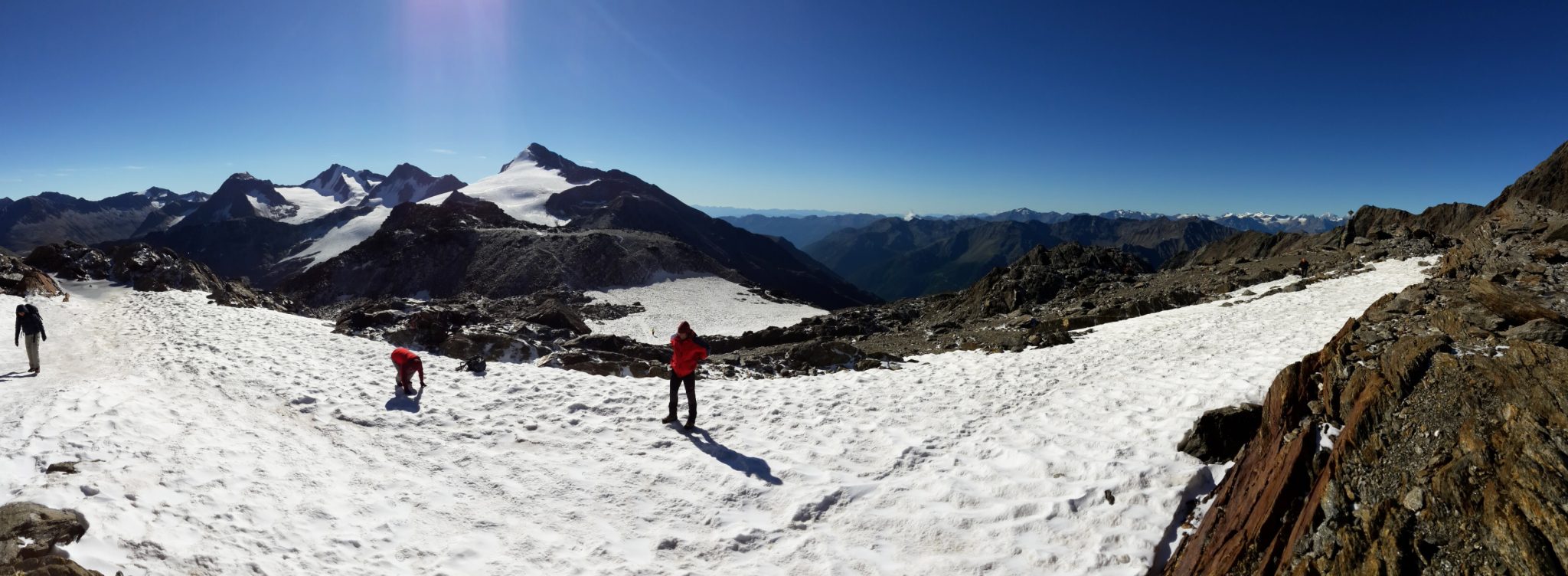Circumstances
leading to the find
On 19 September 1991, German holidaymakers Erika und Helmut Simon discovered a human corpse during a mountain hike at 3210 m above sea level near Tisenjoch/Giogo di Tisa in the Schnalstal/Val Senales Valley. Only his upper body was protruding from the ice. The Simons reported the find to the landlord of the Similaun mountain refuge, who contacted the Austrian police as well as the Italian carabinieri, because the site of the find was situated on the border between the two countries. It was assumed that the man was the unfortunate victim of a mountaineering accident. The following day an initial attempt was made to recover the body. But the rescuers were unable to free the dead man from the ice, and the endeavour was abandoned due to bad weather. Only his axe was taken down to the valley.
Attempts at recovery
The following day, 21 September, a further attempt at recovery failed because no helicopter was available. The same day, the landlord of the Similaun mountain refuge, Markus Pirpamer, visited the site to cover the body with a plastic sheet. The famous South Tyrolean mountaineers Hans Kammerlander and Reinhold Messner also arrived the same day to take a look at the leather clothing and the birch-bark containers. Pirpamer showed them a sketch of the axe, prompting Messner to be the first to suspect that the corpse was very old.

Speculation about the dead body in the mountains:
The two South Tyrolean mountaineers, Reinhold Messner and Hans Kammerlander, came across the find site by accident.
A case for forensic medicine?
The corpse was finally recovered on 23 September. A camera team filmed the mummy being freed from the ice with ice picks. There was still no archaeologist present; a forensic scientist from Innsbruck oversaw the transport of the mummy in a body bag. During the recovery, numerous leather fragments, string, pieces of hide and clumps of hay came to light. Adjacent to the body was a dagger and nearby a long stick that was later identified as a bow. The dead man was flown by helicopter to Vent in the Ötztal Valley, Austria. He was placed in a wooden coffin and driven in a hearse to the Institute of Forensic Medicine in Innsbruck.
An archaeologic sensation
Konrad Spindler, an expert in pre- and early history at Innsbruck University, was finally called in on 24 September. He promptly estimated the mummy’s age to be “at least 4000 years old”. As the corpse had already started to decompose, it was placed in a cold cell that simulated glacier conditions.

On 19 September 1991 two hikers found a frozen mummy.
At first it was thought that a mountain climber had come to an unfortunate end.
Discovery
site
The discovery site was at 3210 m above sea level on Tisenjoch/Giogo di Tisa, below the Finail peak. The corpse lay in a 3-by-7-metre-wide gully and was thus protected from the destructive forces of the moving glacier. Subsequently, he must have been covered by snow and the glacier ice. When the mummy was found in 1991, the ice had melted considerably due to the warm summer, and this is why his upper body was clearly visible protruding from the melt water.
Today, a large stone pyramid stands near the discovery site to commemorate this fortuitous archaeologic find.
Webcam discovery site
The border question
The discovery site was in close proximity to the Austrian-Italian border. On 2 October 1991, an official survey was carried out, which concluded that Ötzi had been found only 92.56m from the border on the South Tyrol side in Italy. This was the result of another curious happenstance. When the border was drawn following Italy’s annexation of South Tyrol in 1922, too much snow had fallen to determine the exact location of the watershed, along which the border was defined. This is why the border was “incorrectly” drawn. However, it remains valid to this day under international law. But it was agreed that the mummy should remain in Innsbruck for the time being in order to carry out archaeologic examinations.
Archaeologic excavations
During the first scientific inspection on 25 September, 1991 the quiver and its contents were recovered. During further excavations in October, string, hide remnants, birch bark and a piece of a grass mat were unearthed. But the area couldn’t be examined systematically until July and August 1992. Archaeologists “delved” into the ice for the first time, removing snow and ice with steam blowers. The well-preserved bearskin cap was found at this point.





